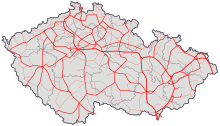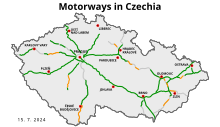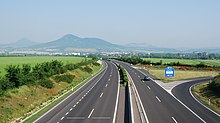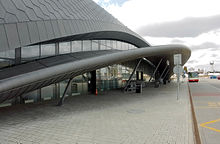
Transport in the Czech Republic relies on several main modes, including transport by road, rail, water and air.

Transport in the Czech Republic relies on several main modes, including transport by road, rail, water and air.

The Czech Republic has a total railway length of 9,435 kilometres (5,863 mi) which makes it a country with the second highest rail density in the world. [1] The vast majority (9,341 kilometres (5,804 mi)) is standard gauge. Electrified railways generally have voltages of 3 kV DC or 25 kV AC. 94 kilometres (58 mi) of track is narrow gauge. The most prominent Czech railway company is the state-owned České dráhy (ČD) (English: Czech Railways). Prague has an underground rapid transit system, the Prague Metro. In addition, the cities of Brno, Liberec, Most, Olomouc, Ostrava, Plzeň, and Prague have tram systems.


The Czech Republic has, in total, 55,653 km (34,581 mi) [2] of roads. It has 1,247 km (775 mi) [3] of motorways. In the 1980s and 1990s there was a significant increase in passenger transport on the roads in the Czech Republic, which was associated with a sharp increase in the accident rate. Between 2007 and 2013, the death rate fell in every year, with a record low of 583 deaths in 2013, compared with the 1994 high of 1,473 casualties. [4] Despite this however, the fatality rate per head of population is moderately high, comparable to the United States. [2]
There are 2 main categories of roads forming the main network: Motorways and Highways. These roads are managed by the state-owned Directorate of Highways and Motorways of the Czech Republic – ŘSD, established in 1997. Among the first modern motorways in the Czech Republic was the motorway from Prague to the Slovak border through Brno whose construction was started on May 2, 1939.
Motorways are dual carriageways with tolls and a speed limit of 130 km/h. Highways can be single and dual carriageway with a speed limit of 90 km/h (dual carriageways are commonly signposted as Roads for motorcars with a speed limit of 110 km/h).
ŘSD currently manages and maintains 1,369 km of motorways (dálnice). [3]
The Vltava is the country's longest river, at 430 km. 358 km of the Elbe (Labe), which totals 1154 km, is also present in the country. An artificial waterway, nowadays used for recreation, is the Baťa Canal.
Děčín, Mělník, Prague, Ústí nad Labem, Moldauhafen in Hamburg (no longer operational, will be handed over to Germany in 2028)


In 2006, the Czech Republic had a total 121 airports. 46 of these airports had paved runways while 75 had unpaved runways. The largest and busiest airport in the Czech Republic is Václav Havel Airport Prague, opened in 1937. Other international airports include Brno–Tuřany Airport, Karlovy Vary Airport, Ostrava Leoš Janáček Airport, Pardubice Airport, Kunovice Airport and Public domestic and private international airport is for example Hradec Králové Airport.
Total: 46 (2007)
Total: 75 (2007)
2 (2006)

This article is about transport in Belarus.

Bosnia and Herzegovina has facilities for road, rail and air transport. There are five international road routes and 20 state highways, with bus connections to many countries. Railways total just over 1,000 km with links to Croatia and Serbia. There are 25 airports, seven of them with paved runways. The Sava River is navigable, but its use is limited.

This article provides a breakdown of the transportation options available in Cameroon. These options are available to citizens and tourists such as railways, roadways, waterways, pipelines, and airlines. These avenues of transport are used by citizens for personal transportation, of goods, and by tourists for both accessing the country and traveling.

Modes of transport in the Central African Republic include road, water, and air. Most of the country is connected to the road network, but not all of it. Some roads in the country do not connect to the rest of the national road network and may become impassable, especially during heavy monsoon rain. Many remote areas that not connected to the country's road network, especially in the eastern part of the country outside of the major cities and towns, can only be reached by light aircraft, boat or on foot. Most roads are unpaved, and which centres on the routes nationales identified as RN1 to RN11. Bangui serves as a seaport, and 900 km of inland waterways are navigable, the main route being the Oubangui river. There is one international airport at Bangui-Mpoko, two other paved airports, and over 40 with unpaved runways.

El Salvador has transport links by road, rail, sea and air.
Modes of transport in Fiji include rail, road, water, and air. The rail network is mainly used for movement of sugar cane. Suva and Lautoka are the largest seaports. There are 122 km of navigable inland waterways. There are two international airports, one other paved airport, and over 20 with unpaved runways. With 333 tropical islands that make up this country, one can expect to use various modes of transport to get to their destination.
Railways: 0 km
Modes of transport in Gabon include rail, road, water, and air. The one rail link, the Trans-Gabon Railway, connects the port of Owendo with the inland town of Franceville. While most of the country is connected by roads, not all areas are accessible. Much of the road network remains unpaved, and it primarily revolves around seven "national routes" labeled N1 through N7. The largest seaports are Port-Gentil and the newer Owendo, and 1,600 km of inland waterways are navigable. There are three international airports, eight other paved airports, and over 40 with unpaved runways. Nearly 300 km of pipelines carry petroleum products, mainly crude oil.
For Soviet transportation, see Transport in the Soviet Union.

Transport in Greece has undergone significant changes in the past two decades, vastly modernizing the country's infrastructure and transportation. Although ferry transport between islands remains the prominent method of transport between the nation's islands, improvements to the road infrastructure, rail, urban transport, and airports have all led to a vast improvement in transportation. These upgrades have played a key role in supporting Greece's economy, which in the past decade has come to rely heavily on the construction industry.
Transportation in Guatemala includes roads, waterways, and airports. It formerly included railways.

Transport infrastructure in Guinea-Bissau is basic, with most roads outside the capital Bissau being unpaved.
Transport in Hungary relies on several main modes, including transport by road, rail, air and water.
This article provides an overview of the transport infrastructure of Latvia.
Transport in Lithuania relies mainly on road and rail networks.
This article describes the transport in Peru.
Most internal transport in Solomon Islands is conducted through boat travel between islands. Road transport infrastructure is rudimentary, with few paved roads.
The transport network in Uruguay consists of 1,673 km of rail network, 7,743 km of paved roads, 1,600 km of navigable waterways, and 11 airports with paved roads.

Vanuatu's undeveloped road system, with fewer than 100 miles of paved roads, consists mostly of dirt tracks suitable only for four-wheel-drive vehicles. Every island has one or two short airstrips where Vanair’s Twin Otter planes land two or three times weekly. In addition, every island has a small port or wharf where small cargo ships and boats regularly dock.
Transport in Crete has undergone significant changes in the past two decades, vastly modernizing the country's infrastructure. Although ferry transport between islands remains the prominent method of transport between the nations islands, improvements to the road infrastructure, rail, urban transport, and airports have all led to a vast improvement in transportation. These upgrades have played a key role in supporting Greece's economy, which in the past decade has come to rely heavily on the construction industry.